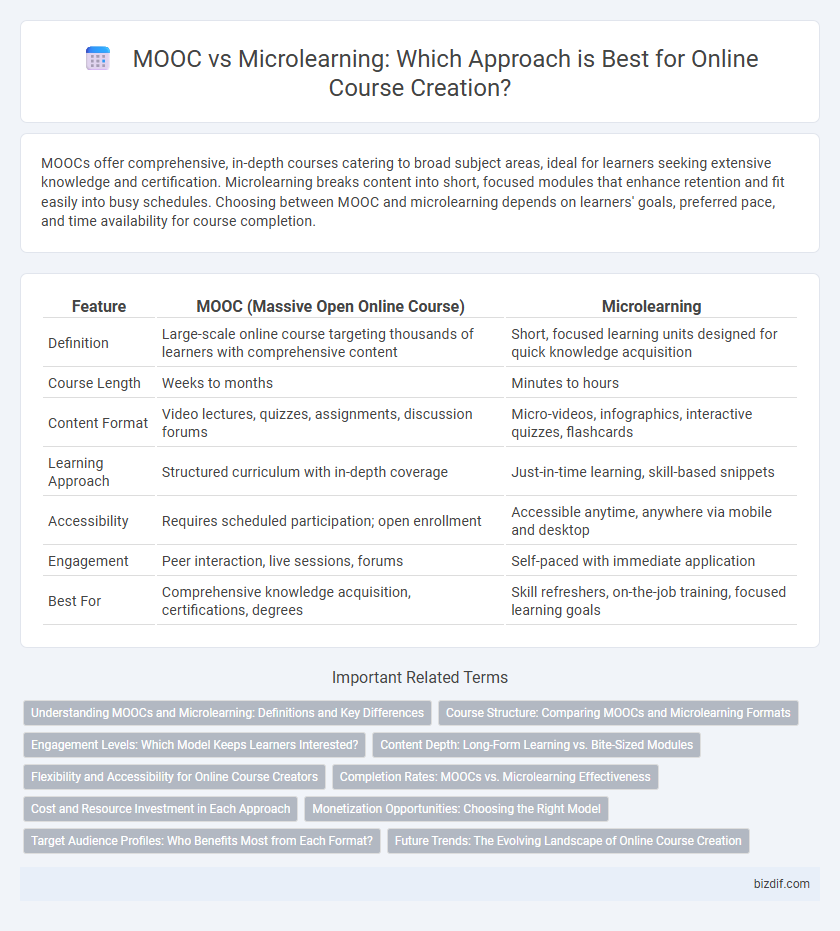MOOCs offer comprehensive, in-depth courses catering to broad subject areas, ideal for learners seeking extensive knowledge and certification. Microlearning breaks content into short, focused modules that enhance retention and fit easily into busy schedules. Choosing between MOOC and microlearning depends on learners' goals, preferred pace, and time availability for course completion.
Table of Comparison
| Feature | MOOC (Massive Open Online Course) | Microlearning |
|---|---|---|
| Definition | Large-scale online course targeting thousands of learners with comprehensive content | Short, focused learning units designed for quick knowledge acquisition |
| Course Length | Weeks to months | Minutes to hours |
| Content Format | Video lectures, quizzes, assignments, discussion forums | Micro-videos, infographics, interactive quizzes, flashcards |
| Learning Approach | Structured curriculum with in-depth coverage | Just-in-time learning, skill-based snippets |
| Accessibility | Requires scheduled participation; open enrollment | Accessible anytime, anywhere via mobile and desktop |
| Engagement | Peer interaction, live sessions, forums | Self-paced with immediate application |
| Best For | Comprehensive knowledge acquisition, certifications, degrees | Skill refreshers, on-the-job training, focused learning goals |
Understanding MOOCs and Microlearning: Definitions and Key Differences
Massive Open Online Courses (MOOCs) offer comprehensive, university-level curricula accessible to thousands of learners simultaneously, emphasizing depth and academic rigor. Microlearning breaks content into brief, focused segments designed for quick absorption and retention, ideal for skill-based training and just-in-time learning. The key difference lies in MOOCs' extensive, structured program approach versus Microlearning's targeted, flexible modules tailored to busy schedules and specific learning objectives.
Course Structure: Comparing MOOCs and Microlearning Formats
MOOCs typically follow a comprehensive course structure with multiple modules, video lectures, quizzes, and assignments designed for in-depth learning over several weeks. Microlearning breaks content into bite-sized, focused lessons that target specific skills or topics, allowing for flexible, on-demand access and quicker knowledge retention. This modular approach in microlearning supports rapid skill acquisition, contrasting with the sequential, extensive structure found in MOOCs.
Engagement Levels: Which Model Keeps Learners Interested?
MOOCs typically offer comprehensive, structured content that appeals to learners seeking in-depth knowledge but may suffer from lower engagement due to lengthy sessions and passive learning formats. Microlearning delivers bite-sized modules that enhance learner retention and engagement by allowing flexible, focused interaction tailored to busy schedules. Data shows microlearning increases completion rates by up to 50%, making it a more effective model for sustaining learner interest in online course creation.
Content Depth: Long-Form Learning vs. Bite-Sized Modules
MOOCs offer long-form learning with comprehensive course content covering in-depth theories and extensive resources suitable for deep conceptual understanding. Microlearning delivers bite-sized modules focusing on targeted skill acquisition and immediate application, enhancing retention through spaced repetition. Both formats cater to different learning needs, with MOOCs ideal for immersive education and microlearning suited for quick, flexible knowledge boosts.
Flexibility and Accessibility for Online Course Creators
MOOCs offer extensive flexibility by providing comprehensive course materials accessible anytime, supporting diverse learning paces and schedules. Microlearning enhances accessibility through bite-sized content ideal for mobile devices, enabling quick skill acquisition and on-the-go learning. Online course creators benefit from MOOCs' broad reach and deep engagement, while microlearning delivers targeted flexibility for learners with limited time.
Completion Rates: MOOCs vs. Microlearning Effectiveness
Microlearning demonstrates significantly higher completion rates compared to MOOCs, often exceeding 70%, due to its short, focused modules that cater to learners' limited attention spans. MOOCs, while offering comprehensive course content, typically experience completion rates below 15% because of their length and lack of personalized pacing. The bite-sized nature of microlearning aligns better with learner engagement patterns, enhancing retention and effective knowledge transfer in online course creation.
Cost and Resource Investment in Each Approach
MOOCs typically involve high initial costs and resource investment due to large-scale platform development, comprehensive content creation, and expert instructor compensation, making them suitable for wide audience reach but requiring substantial funding. Microlearning demands lower costs and fewer resources, as it centers on creating concise, targeted modules that can be rapidly produced and updated, enabling organizations to deliver training efficiently and cost-effectively. Choosing between MOOCs and microlearning depends on budget constraints and the scalability needs of the educational program.
Monetization Opportunities: Choosing the Right Model
MOOCs offer broad monetization opportunities through subscription fees, certification charges, and corporate partnerships, benefiting large-scale course delivery. Microlearning capitalizes on frequent, bite-sized purchases, leveraging in-app transactions, micro-subscriptions, and targeted ads for steady revenue streams. Selecting the right model depends on audience engagement patterns and potential for scalable income generation.
Target Audience Profiles: Who Benefits Most from Each Format?
MOOCs appeal primarily to self-motivated learners, professionals seeking comprehensive subject mastery, and students requiring flexible, in-depth study options. Microlearning targets busy professionals, corporate trainees, and on-the-go learners needing quick, focused knowledge bursts for skill enhancement or immediate application. Identifying learner goals, time availability, and content complexity ensures choosing the optimal course format aligned with target audience needs.
Future Trends: The Evolving Landscape of Online Course Creation
MOOCs continue to dominate large-scale online learning with extensive course offerings and global reach, while microlearning gains traction for its bite-sized, on-demand content tailored to busy learners. Emerging trends in online course creation emphasize personalized learning paths, AI-driven content delivery, and mobile-first design, enhancing engagement and retention. The future landscape integrates adaptive technologies that blend MOOCs' comprehensive curriculum with microlearning's flexibility to meet diverse learner needs efficiently.
MOOC vs Microlearning Infographic

 bizdif.com
bizdif.com